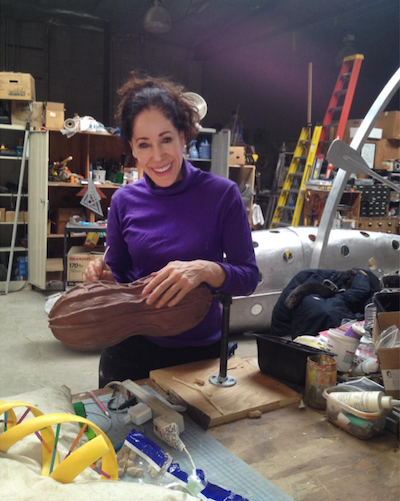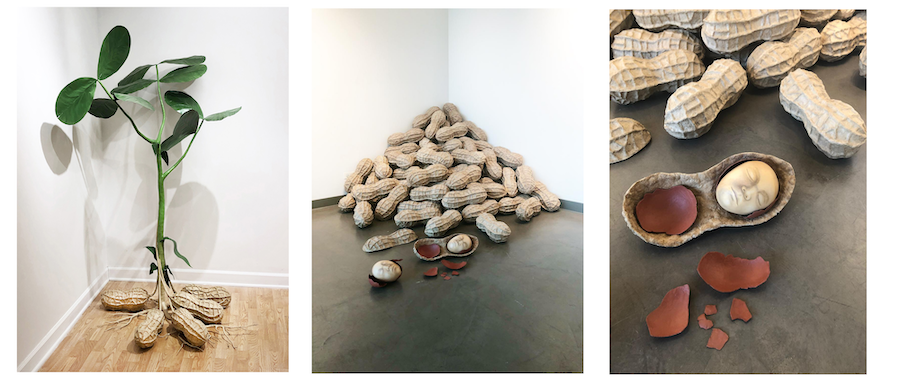Artist Q&A: Victoria Fuller


By CGN Staff
If you have taken a walk around Chicago in the past decade and noticed any whimsical public art, there's a good chance you have stumbled across a work by Victoria Fuller. A graduate of SAIC and a Chicago-based artist for several years, Fuller has spent her career working in sculpture and painting. Following a year in lockdown, this spring she is the featured artist in Ephemera, a show at The Art Center Highland Park that begins in May. We asked Victoria a few questions about how she got started as an artist, what challenges and opportunities she's experienced in recent months, and what might be next.
CGN: What was the first piece of art (or artist) that really mattered to you? Do you remember how old you were?
Victoria Fuller: I was 5 years old, on the Pennsylvania farm I grew up on, when a friend and I disturbed a swarm of bees. I remember our babysitter first put mud on our bee stings, and then she said that when a bee stings you, their stinger comes out and they die. In my 5-year-old mind, I worried about the dead bees. I imagined that their souls would become angels in heaven, so I drew a picture of a bee with a halo. When my father asked me about it, I responded it was a “Bee Angel.” He was enchanted with the idea, so he turned it into our Christmas card that year.
CGN: At what point did you determine you wanted to be an artist? When did you choose to pursue sculpture?
VF: My grade school art teacher sat me across from another student and told us each to draw a portrait of the other. I had never done that before. When I was finished I was astonished to see the image I drew looked just like my classmate. My parents encouraged my talent, and the first art award that I won was for a decorated Easter egg. By high school I decided I wanted to major in art at college. At the University of Denver, I took classes in painting, ceramics, sculpture and printmaking. A visiting installation artist assigned us to find man-made objects in hardware stores and make art with them. That was when I was introduced to the concept of found object art and the artist Marcel Duchamp.
After two years at the University of Denver, I moved to Aspen and continued to paint, make ceramics, dabble in paper making, and take classes at Anderson Ranch Art Center. While completing my college degree through the University Without Walls program through Loretto Heights College, I did two semesters at The San Francisco Art Institute. There someone stole one of my paintings in the storage racks. The attendant shrugged his shoulders and said, “Perhaps a student who couldn’t afford materials took your painting and painted over it.” Discouraged, and not feeling it was safe to store paintings at school, I started experimenting with sculpture. Now, I do both painting and sculpture in a variety of materials and forms, as well as work with found and appropriated objects.
CGN: What prompted you to pursue an MFA?
VF: After getting married and divorced, and living in New York City for a year to seriously pursue my career, I returned to Aspen for a short period. Then I decided that if I was to be taken seriously, I should get an MFA. At that point I was 39 years old, and I was accepted at SAIC. I wasn't accepted at some other schools, but ultimately I was glad because I felt out of place on those campuses. When I came to Chicago, it felt right. I loved the Art Institute, and some of my art heroes from the “Harry Who” movement were here. Later I had the distinct pleasure to have had Jim Nutt and Barbara Rossi as graduate advisors.

CGN: Do you have any advice for current MFA students or to recent graduates?
VF: When I entered graduate school, I had had a career in art for several years and was able to discern and trust my own judgments about what worked and what didn’t in making my art. After starting school, I lost that innate sense of knowing my decisions because the teachers and students would question and criticize my choices – which is what happens in critiques. You look at aspects of your work you may not have considered. However, it took me a year and a half to once again trust myself when making my work. I guess my wisdom would be to take critiques with a grain of salt. Listen to what they say, consider it, but if you know what is right for you, stand up for yourself and continue on your path. If you know you are making the right choices, then continue. For those who have recently graduated, I would say that networking with fellow artists and people in the art world is very important. Those connections will help you get into shows and advance. Go to art openings (someday) and network on social media.
CGN: What do you wish you knew when you were first starting out?
VF: I didn’t know anything about the business of art, and it was not taught in art school at that time. I wish I had known more about that. I really didn’t know about the networking either.
CGN: You received an individual artist grant from DCASE in 2019. Was there a specific project you worked on as a result of that?
VF: Yes, I created an inflatable sculpture called Bring Back the Extinct Northern White Rhino. It’s a life size replica of a rhino, 13’ x 5.5’ x 4,’ made of vinyl, with a hide of printed faux wrinkles and texture. It inflates and deflates repetitively on a 3 minutes cycle, continuing until the gallery space closes. When deflated, we are reminded that it is extinct; when inflated, it references the magnificence of the species when it was alive and the attempt to bring it back through “artificial reproductive techniques,” via frozen sperm and eggs implanted in a closely related subspecies. The inflation and deflation are also like inhaling and exhaling lungs, symbolizing the breath of life.
CGN: Have you ever been walking and happened upon one of your own works on display?
VF: I haven’t had that experience, exactly, but one of my artworks, Directing Traffic, made of highway signs, is along McCormick Blvd., just south of Skokie Sculpture Park, in Lincolnwood. I did encounter it when I went on a group bike ride. We stopped and took pictures next to it. I guess I felt proud to show it off to people.

CGN: What has been your most enjoyable project or commission?
VF: I love all of my artworks, they are like my children, but making Shoe of Shoes, was my first large-scale public artwork, and I learned a lot from it. It was fun to see my concept of a giant shoe made from around 2,000 cast aluminum shoes become a reality. I first showed it at Navy Pier, and then it went to St. Louis, where it was in a show at City Museum, called The Really Big Shoe Show. Then it was purchased by Brown Shoe, also in St. Louis. They have since rebranded to Caleres Shoes. Shoe of Shoes sits outside of their headquarters.
CGN: Almost one year into the pandemic, what do you miss? Have you experienced anything positive or surprising?
VF: I miss going to art openings and talking openly without wearing masks. I miss getting together with friends at a restaurant and gathering at people’s homes for parties.
I guess the silver lining is that I have a lot of time to myself, without much interruption, to work on art. I admit the time leading up to the elections in the fall was distracting, and I was glued to the TV to see what was going to happen, and then the horrible insurrection at the Capitol happened. I didn’t get much artwork done during that stressful time.
But overall this year has been good for me. I have been in several online shows, and I was juried into the Rockford Midwest Biennial and the Evanston and Vicinity Show. I was honored to have been awarded the Dean Alan Olson Purchase Award by the Rockford Art Museum and I won Best of Show at the Evanston and Vicinity Show, tied with another artist Annie Zirin.
CGN: What are you working on now?
VF: I am working on a series called On the Brink, revolving around the threatened circumstance of many of the animals on earth, that are either extinct, nearly extinct, or endangered. The human species should be included in that category, given the state of the planet and the situation of pollution, plastic waste and climate change. I am presently working on making Sea Turtle hatchlings and their eggs, as part of an installation that I plan to do with sand.
I will also be the Featured Artist at the Highland Park Art Center's Ephemera: The Power of Impermanence exhibition which will run from May 7-June 12, including the Center's annual benefit on May 8. I will guest jury the show and will feature some of my favorite works focusing on systems of man and nature and the impact of that nexus. Pieces will include my Many Sun Series as well as Bring Back the Extinct Northern White Rhino mentioned previously.






